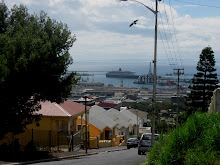 This morning's walk on Fish Hoek beach revealed lots of kelp washed up after last night's storm. Many of the kelp stipes were encrusted with barnacles which are the most fascinating creatures. They are highly modified crustaceans and this is their adult phase. After swimming around the ocean as planktonic larvae, the adults settle down, head first, and cement themselves to a substrate, secreting a shell and extending their legs (or cirri) through a hole at the top to filter out food particles. I think this one might be the White Dwarf Barnacle (Notomegabalanus algicola).
This morning's walk on Fish Hoek beach revealed lots of kelp washed up after last night's storm. Many of the kelp stipes were encrusted with barnacles which are the most fascinating creatures. They are highly modified crustaceans and this is their adult phase. After swimming around the ocean as planktonic larvae, the adults settle down, head first, and cement themselves to a substrate, secreting a shell and extending their legs (or cirri) through a hole at the top to filter out food particles. I think this one might be the White Dwarf Barnacle (Notomegabalanus algicola).These were the creatures that so fascinated Charles Darwin too.



















 Several subdivisions later it was bought by the formidable Hester de Villiers, who was the owner when this photo was taken in the early twentieth century. The scar made by the stone quarry (opened in 1896) in the hill above can be seen even to this day.
Several subdivisions later it was bought by the formidable Hester de Villiers, who was the owner when this photo was taken in the early twentieth century. The scar made by the stone quarry (opened in 1896) in the hill above can be seen even to this day.  Today, a hundred years later. The blue arrow marks the spot of the naval mess, hidden behind the ugly beach buildings.
Today, a hundred years later. The blue arrow marks the spot of the naval mess, hidden behind the ugly beach buildings.






































